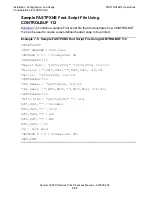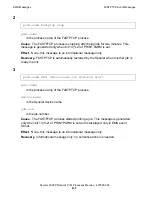
Troubleshooting and Using the Trace Facility
Spooler FASTP Network Print Processes Manual — 427528-006
8 - 3
Using the Trace Facility
If possible, a copy of the actual print job in 129 format. This can be
obtained by using the following command:
peruse
-job #
nnn
list / out save129 / all
If a FONT job is used, a copy of the Font compiler input file or a copy of the
FONT job in 129 format.
For AWAN devices, the output of the following commands:
SHOW PORT
n
SHOW TELNET LISTENER 200
x
For AWAN 3886 models only, also the output of the following command:
SHOW PORT
n
AWAN
A copy of the shadow trace file
For FASTPTCP, unstructured format files are preferred. When sending these
files, be sure to use binary transfer. Although not as useful, the SHAP list file
output can also be sent.
For the remaining FASTP network print processes, entry-sequenced files are
used. When transferring these files, perform the follow special handling:
1. Use the
FUP COPY shadow,,H
command to generate the file.
2. Send the file on a BACKUP tape or in a PAK file.
Using the Trace Facility
As an aid to troubleshooting, all FASTP network print processes include a trace facility.
When tracing is enabled, data sent to a printer, data received from a printer, and
certain other internal events such as Spooler supervisor messages are logged to one
or more shadow trace files. Tracing is performed on a per-device basis. All shadow
trace files have the following characteristics:
A maximum of eight trace files can be specified for each device.
If only one trace file is specified, tracing stops when the file is full.
If more than one file is specified, tracing wraps around the sequence of files. When
a file becomes full, the print process purges the data from the next file and begins
writing to it. When the last file in the sequence is full, the print process returns to
the first file in the sequence, and so on.
There are two types of shadow trace files. The original, entry-sequenced format, and a
new unstructured format.
An entry-sequenced trace file has the following characteristics:
Is supported by all the FASTP network print processes, including FASTPTCP






























